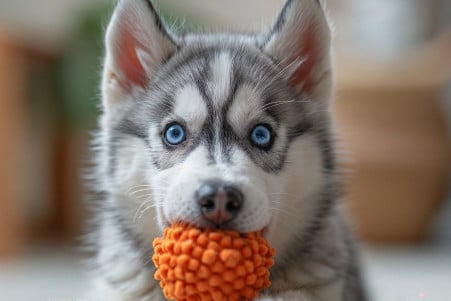Why Do Dogs Love Tennis Balls? It's More Complicated Than You Think
28 May 2024 • Updated 27 May 2024

Why do dogs love chasing, fetching, and even hoarding those fuzzy yellow tennis balls? It turns out that the answer is a bit more complicated than you might think. Dogs are natural hunters and retrievers, and tennis balls are the perfect combination of a prey-like object that can be caught and a ball that bounces, which is why dogs love them so much.
In this article, we'll take a closer look at the research from animal behaviorists, pet experts, and veterinarians to find out exactly why dogs love tennis balls. While the reasons are based on instinctual predatory behaviors, these experts' findings will help us understand the psychology of a dog's love of tennis balls, the impact of conditioning and reinforcement, and the potential health risks of this beloved doggy activity.
Why do dogs love tennis balls?
Evolutionary Origins: From Wolf to Woof
The reason dogs love tennis balls can be traced back to the hunting behaviors of their wolf ancestors. According to research cited by Tug-E-Nuff, wolves had an innate need to bring their kills back to their packs, a behavior that has been passed down to pet dogs in the form of fetching objects like tennis balls. In fact, some dogs, including Labradors, were even bred for their strong retrieving skills, according to the Humane Society of Naples, which further reinforced this natural behavior.
The entire process of chasing and retrieving objects activates the pleasure centers in the dog's brain, which makes fetch and similar activities enjoyable, according to Tug-E-Nuff's doggy psychology analysis. Meanwhile, a TryFi article notes that engaging a dog's prey drive through games like fetch offers mental stimulation and an opportunity to express their hunting instincts. This insight into the deep evolutionary roots of their wolf ancestors' behaviors helps to explain why the game of fetch is such a popular and rewarding activity for our dogs.
Potential Pitfalls: When Ball Obsession Goes Too Far
While playing fetch with a tennis ball can be fun for dogs, ball obsession can lead to a number of problems. As PetHelpful explains, dogs can become so fixated on the ball that they won't listen to their owners and can even start to show signs of stress.
Meanwhile, the American Kennel Club points out that dogs that chew on tennis balls too much can experience dental issues like enamel wear and gum abrasions. What's more, tennis balls can be a choking hazard and even cause intestinal blockages if dogs swallow pieces of them, according to WellPets. To avoid injuries, overheating, and the development of obsessive behaviors, it's important to make sure dogs play with tennis balls in moderation and under supervision.
Safer Alternatives: What to Use Instead of Tennis Balls
Although tennis balls are the most common, there are several safer alternatives that can still meet a dog's fetching needs. The American Kennel Club recommends rubber balls made for aggressive chewers since they are more durable and less damaging to teeth. Meanwhile, Wolfie's Place suggests that cloth or rope toys can provide the same kind of fetching experience without the risk of choking.
In addition, interactive puzzle toys and treat-dispensing balls can provide dogs with mental stimulation and fun, as noted by 30A Dog Trainers. A veterinarian or dog trainer can help pet owners determine the best toys for their dog based on their specific needs and preferences.
How to Train for Healthy Play: Redirecting Ball Drive
Instead of trying to eliminate a dog's obsession with balls, it's best to redirect it through training and boundaries, as proposed by AwokenK9. Training dogs to respond to commands like 'drop it' and 'leave it' can help ensure that they stay under control during playtime, and boundaries, such as only allowing play in certain areas and limiting the amount of time spent playing, can help ensure that the obsession doesn't get out of hand, according to ThatMutt.com.
It's also important to make sure that the ball is only used as a reward for good behavior and not to reinforce bad habits. Finally, making sure that dogs get regular breaks and mental stimulation can help prevent them from getting too worked up or frustrated, as noted in the training tips from Wag!. By redirecting a dog's ball drive through training, dog owners can make sure that they have a positive, healthy relationship with their pets.
Moderation and Supervision: Avoiding Health Pitfalls
While tennis balls can provide a fun outlet for dogs, overuse and lack of supervision can result in some serious health pitfalls. As noted in an article on East Valley Animal, the constant chewing can lead to dental problems, digestive problems from swallowing pieces, and even poisoning. Moreover, the high-impact nature of playing fetch can lead to joint and muscle strains, especially in older and overweight dogs.
As pointed out in Pooches At Play, owners should keep fetch sessions short and sweet and watch for signs of overheating and overexertion. By working with a vet, as suggested by Long Haul Trekkers, owners can learn about the potential pitfalls and come up with safe play plans that are tailored to their dog's specific needs.
Conclusion: Understanding and Managing Ball Drive
The ball drive in dogs is a complex behavior that has its origins in the evolutionary history of the species and the predatory behaviors that have helped dogs survive for thousands of years. While the ball drive can be a source of enrichment and an opportunity for bonding between dogs and their owners, it can also be dangerous.
It's important to manage the ball drive in dogs through a combination of moderation, supervision, and the use of safer toys. In addition, training and setting limits can help ensure that dogs are able to express their ball drive in a safe and healthy way. By learning about the science of ball drive, dog owners can better manage their dog's ball obsession.


